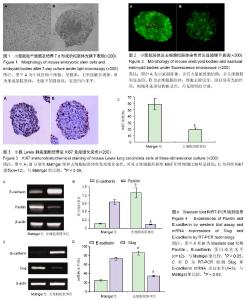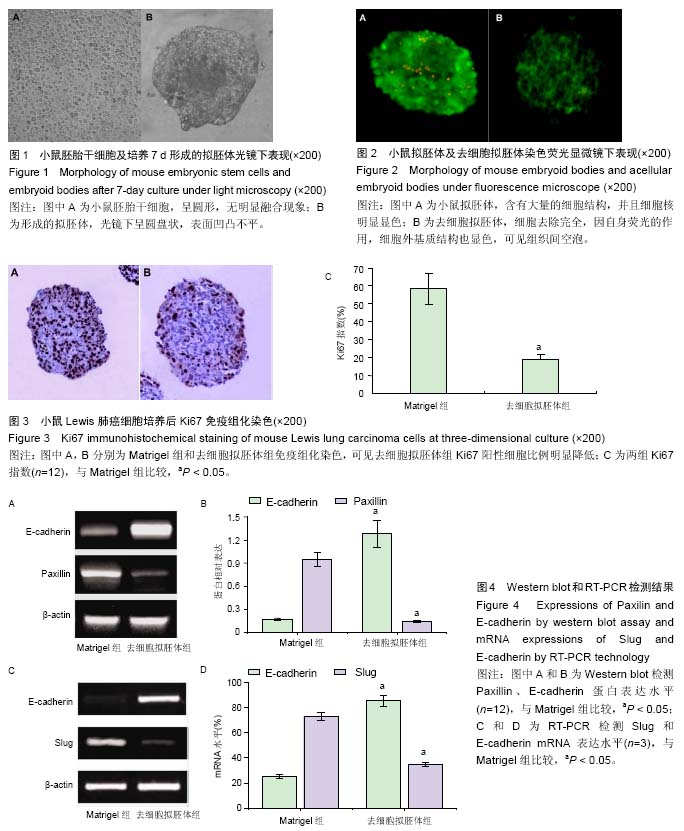| [1] Hendrix MJ, Seftor EA, Seftor RE, et al. Reprogramming metastatic tumour cells with embryonic microenvironments. Nat Rev Cancer. 2007;7(4):246-255.
[2] Lopez JI, Kang I, You WK, et al. In situ force mapping of mammary gland transformation. Integr Biol (Camb). 2011;3(9):910-921.
[3] Dong W, Du J, Shen H, et al. Administration of embryonic stem cells generates effective antitumor immunity in mice with minor and heavy tumor load. Cancer Immunol Immunother. 2010;59(11):1697-1705.
[4] 孟龙,张阳德.小鼠Lewis肺癌细胞与胚胎干细胞体外共培养的生物学行为[J].中国组织工程研究与临床康复, 2010, 14(36):6794-6797.
[5] Bratt-Leal AM, Carpenedo RL, McDevitt TC. Engineering the embryoid body microenvironment to direct embryonic stem cell differentiation. Biotechnol Prog. 2009;25(1):43-51.
[6] Lin H, Yang G, Tan J, et al. Influence of decellularized matrix derived from human mesenchymal stem cells on their proliferation, migration and multi-lineage differentiation potential. Biomaterials. 2012;33(18): 4480-4489.
[7] Goh SK, Olsen P, Banerjee I. Extracellular matrix aggregates from differentiating embryoid bodies as a scaffold to support ESC proliferation and differentiation. PLoS One. 2013;8(4):e61856.
[8] Sart S, Ma T, Li Y. Extracellular matrices decellularized from embryonic stem cells maintained their structure and signaling specificity. Tissue Eng Part A. 2014; 20(1-2):54-66.
[9] Lü WD, Zhang L, Wu CL, et al. Development of an acellular tumor extracellular matrix as a three-dimensional scaffold for tumor engineering. PLoS One. 2014 Jul 29;9(7):e103672.
[10] Raof NA, Mooney BM, Xie Y. Bioengineering embryonic stem cell microenvironments for the study of breast cancer. Int J Mol Sci. 2011;12(11): 7662-7691.
[11] Raof NA, Raja WK, Castracane J, et al. Bioengineering embryonic stem cell microenvironments for exploring inhibitory effects on metastatic breast cancer cells. Biomaterials. 2011;32(17):4130-4139.
[12] Ingber DE. Can cancer be reversed by engineering the tumor microenvironment. Semin Cancer Biol. 2008; 18(5): 356-364.
[13] Crapo PM, Gilbert TW, Badylak SF. An overview of tissue and whole organ decellularization processes. Biomaterials. 2011;32(12):3233-3243.
[14] Mao AS, Mooney DJ. Regenerative medicine: Current therapies and future directions. Proc Natl Acad Sci U S A. 2015;112(47):14452-14459.
[15] Tapias LF, Ott HC. Decellularized scaffolds as a platform for bioengineered organs. Curr Opin Organ Transplant. 2014;19(2):145-152.
[16] Nair R, Shukla S, McDevitt TC. Acellular matrices derived from differentiating embryonic stem cells. J Biomed Mater Res A. 2008;87(4):1075-1085.
[17] Jung KW. Perspectives on human stem cell research. J Cell Physiol. 2009;220(3):535-537.
[18] Lo B, Parham L. Ethical issues in stem cell research. Endocr Rev. 2009;30(3):204-213.
[19] Robertson JA. Embryo stem cell research: ten years of controversy. J Law Med Ethics. 2010;38(2): 191-203.
[20] Lye JL, Soon LK, Wan Ahmad WA, et al. Knowledge and Attitude about Stem Cells and Their Application in Medicine among Nursing Students in Universiti Sains Malaysia, Malaysia. Malays J Med Sci. 2015;22(4): 23-31.
[21] Kulesa PM, Kasemeier-Kulesa JC, Teddy JM, et al. Reprogramming metastatic melanoma cells to assume a neural crest cell-like phenotype in an embryonic microenvironment. Proc Natl Acad Sci U S A. 2006; 103(10):3752-3757.
[22] Bischof AG, Yüksel D, Mammoto T, et al. Breast cancer normalization induced by embryonic mesenchyme is mediated by extracellular matrix biglycan. Integr Biol (Camb). 2013;5(8):1045-1056.
[23] Dong W, Qiu C, Shen H, et al. Antitumor effect of embryonic stem cells in a non-small cell lung cancer model: antitumor factors and immune responses. Int J Med Sci. 2013;10(10):1314-1320.
[24] Benton G, Arnaoutova I, George J, et al. Matrigel: from discovery and ECM mimicry to assays and models for cancer research. Adv Drug Deliv Rev. 2014;79-80: 3-18.
[25] Benton G, Kleinman HK, George J, et al. Multiple uses of basement membrane-like matrix (BME/Matrigel) in vitro and in vivo with cancer cells. Int J Cancer. 2011; 128(8): 1751-1757.
[26] Li LT, Jiang G, Chen Q, et al. Ki67 is a promising molecular target in the diagnosis of cancer (review). Mol Med Rep. 2015;11(3):1566-1572.
[27] Huang G, Chen S, Wang D, et al. High Ki67 Expression has Prognostic Value in Surgically-Resected T3 Gastric Adenocarcinoma. Clin Lab. 2016;62(1-2): 141-153.
[28] Omran OM, Al Sheeha M. Cytoskeletal Focal Adhesion Proteins Fascin-1 and Paxillin Are Predictors of Malignant Progression and Poor Prognosis in Human Breast Cancer. J Environ Pathol Toxicol Oncol. 2015; 34(3):201-212.
[29] Athanasopoulou A, Aroukatos P, Nakas D, et al. Decreased ezrin and paxillin expression in human urothelial bladder tumors correlate with tumor progression. Urol Oncol. 2013;31(6):836-842.
[30] Chan KK, Matchett KB, McEnhill PM, et al. Protein deregulation associated with breast cancer metastasis. Cytokine Growth Factor Rev. 2015;26(4):415-423.
[31] Repetto O, De Paoli P, De Re V, et al. Levels of soluble E-cadherin in breast, gastric, and colorectal cancers. Biomed Res Int. 2014;2014:408047.
[32] Baranwal S, Alahari SK. Molecular mechanisms controlling E-cadherin expression in breast cancer. Biochem Biophys Res Commun. 2009;384(1):6-11.
[33] Wang Y, Shi J, Chai K, et al. The Role of Snail in EMT and Tumorigenesis. Curr Cancer Drug Targets. 2013; 13(9):963-972.
[34] Zhang J, Cheng Q, Zhou Y, et al. Slug is a key mediator of hypoxia induced cadherin switch in HNSCC: correlations with poor prognosis. Oral Oncol. 2013;49(11):1043-1050. |

